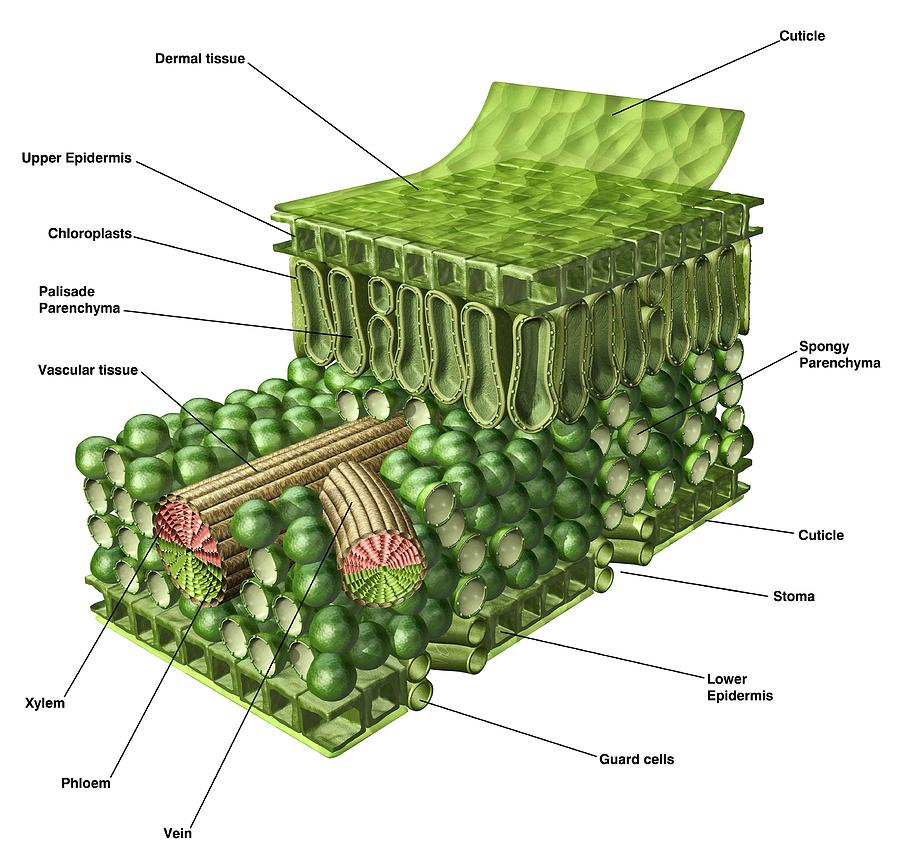
Dicot leaf Biology plants, Plant science, Plant physiology
Find these structures on the attached diagram of cellular leaf tissues. Epidermis - The leaf's outer layer and protective "skin" surrounding leaf tissues. Cuticle - A waxy protective.
leaf structure Labelled diagram
GCSE WJEC Structure of plants - WJEC Leaf structure Plants adapt in order to efficiently collect raw materials required for photosynthesis. These raw materials must be transported through the.
:max_bytes(150000):strip_icc()/leaf_crossection-57bf24a83df78cc16e1f29fd.jpg)
Plant Leaves and Leaf Anatomy
They are attached by a continuous vascular system to the rest of the plant so that free exchange of nutrients, water, and end products of photosynthesis (oxygen and carbohydrates in particular) can be carried to its various parts. Leaves are initiated in the apical bud (growing tip of a stem) along with the tissues of the stem itself.

Changing Seasons, Fall Leaves, and Your Car's Paint
The air space found between the spongy parenchyma cells allows gaseous exchange between the leaf and the outside atmosphere through the stomata. In aquatic plants, the intercellular spaces in the spongy parenchyma help the leaf float. Both layers of the mesophyll contain many chloroplasts. Figure 30.10. 1: Mesophyll: (a) (top) The central.

Diagram of a leaf showing typical features of a dicot Flickr
Leaves are the powerhouse of plants. In most plants, leaves are the major site of food production for the plant. Structures within a leaf convert the energy in sunlight into chemical energy that the plant can use as food.

Labeled Diagram Of A Leaf
A leaf diagram representing the parts of a leaf Read more: Types of Stipules Venation Venation is defined as the arrangement of veins and the veinlets in the leaves. Different plants show different types of venation. Generally, there are two types of venation:

How to Draw Parts of Leaf/How to Draw a leaf and Label parts/How to
How do they work? An microphotograph of a stoma shows the two guard cells which regulate its opening and closure to limit water loss, excrete oxygen, and absorb carbon dioxide. The openings or pores in stomata are formed by two specialized sclerenchymal cells, the guard cells ( Figure above ).

Anatomy of a Leaf Diagrams 101 Diagrams
Part of Leaf Diagram | How To Draw labelled Diagram of Leaf easy - Step by Step.This video explains about How to Draw Part of Leaf Diagram in easy steps to r.

Label the following diagram of a leaf. Brainly.in
Leaves are the site of photosynthesis in plants. Plant leaves help to sustain life on earth as they generate food for both plant and animal life. The leaf is the site of photosynthesis in plants. Photosynthesis is the process of absorbing energy from sunlight and using it to produce food in the form of sugars. Leaves make it possible for plants.

Ts Of Dicot Leaf Diagram Amyhj
The midrib extends from the petiole to the leaf tip and contains the main vein. Additional veins branch from the midvein. The margin is the edge of the leaf. Figure 3.4.1.2 3.4.1. 2: The petiolate leaves of the geranium consist of a petiole and blade (lamina). The wide lamina is attached to the stalk-like petiole.

Parts of a Leaf YouTube
Allow the nail polish about four hours to dry. Using a pair of tweezers, peel off a film (thin skin) from the surface of the leaf. Gently place the film onto a microscope slide and cover with a cover slip. Start with low power and increase to 100x (frequency of stoma can be counted at 100x) Record your observations.

Labeled Diagram Of A Leaf hubpages
Definition of a Leaf: The leaf is a flattened, lateral outgrowth of the stem in the branch, developing from a node and having a bud in its axil. It is normally green in colour and manufactures food for the whole plant. The leaves take up water and carbon dioxide and convert them into carbohydrates in the presence of sunlight and chlorophyll.

Leaf Labelled Stock Photo Download Image Now iStock
Parts of a Leaf Diagram 1. Petiole It is the stalk that connects a leaf to the stem of the plant, it is made of complex conducting tissues called vascular tissues. Functions Providing support to the leaf and keeps it erect Transporting water and nutrients absorbed by the roots to the leaves

Parts of a Leaf, Their Structure and Functions With Diagram Science
Leaf Parts. Leaves are generally composed of a few main parts: the blade and the petiole. Figure 13.1.2 13.1. 2: A leaf is usually composed of a blade and a petiole. The blade is most frequently the flat, photosynthetic part. The petiole is a stem that attaches the leaf blade to the main stem of the plant.

Plant Leaf Structure Photograph by Carlos Clarivan Fine Art America
This interactive leaf diagram is perfect for teaching leaf structure. Each of the different parts of a leaf is labelled. Parts included: Show more Related Searches photosynthesis structure of a leaf leaf structure stomata leaf diagram photosynthesis worksheets Ratings & Reviews Curriculum Links Make a Request
:max_bytes(150000):strip_icc()/parts_of_a_leaf-56abaed23df78cf772b5625a.jpg)
Plant Leaves and Leaf Anatomy
Figure 30.8.1 30.8. 1: Parts of a leaf: A leaf may seem simple in appearance, but it is a highly-efficient structure. Petioles, stipules, veins, and a midrib are all essential structures of a leaf. Within each leaf, the vascular tissue forms veins. The arrangement of veins in a leaf is called the venation pattern.